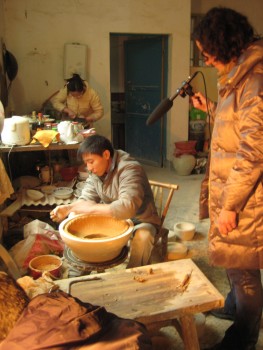Made in China: Professor Maris Gillette and Students Explore Lives of Chinese Porcelain Workers in Documentary Film

Worker Yang Yajun is filmed in his workshop hand-pressing porcelain clay into a mold, a technique that dates back to the Yuan dynasty. He is making an antique replica of a Yuan dynasty pot.
Details
When Associate Professor of Anthropology Maris Gillette was helping the Philadelphia Museum of Art curate a display of porcelain from the Chinese city of Jingdezhen in 2003, she began thinking about the people whose hands crafted the fine wares.“There had been nothing written about them,” she says,“just the objects.”
Gillette made her first research trip to Jingdezhen to learn more about these porcelain industry workers in the winter of 2003, and made subsequent trips over the course of the next three years. During the recent winter break, Gillette traveled to the city once again with two students, Patrick Lozada '11 and Diana Tung BMC '10, to shoot a documentary film about the workers. The trip was funded by the Center for Peace and Global Citizenship.
“Film is a wonderful medium for reaching people,” says Gillette.“There's a liveliness, an emotional closeness, and an experiential dimension that academic books don't have.” Using film also allowed Gillette to integrate her students into her research and use them productively.
“To my pleasant surprise,” says Patrick Lozada,“I was able to work with [Gillette] on not only the more mundane parts of filming like carrying equipment and setting up lighting but also creating my own shots and really working with the film on a creative level.”
Gillette wants potential audiences for the film to understand the process of porcelain making in Jingdezhen, where workers typically focus on one aspect of the process, such as glazing or hand-painting, for the entirety of their careers.“People don't know much about the techniques,” she says.“The students found it mesmerizing to see what these people can do with their hands.”
But she also wants to show the lives of the workers.
Jingdezhen has had a porcelain industry for 1,000 years, and for centuries the Chinese government played a central role. But after the Communist Party instituted reforms that moved the economy toward capitalism, the state-run porcelain enterprises shut down. Gillette spoke with workers at length about the changes the competitive market economy has brought. On the one hand, she says,“It's produced more agile entrepreneurs, who respond quickly to the changes in the market demand.” But on the other hand, quality of life has suffered as workers, who have no pensions or medical insurance, toil longer hours to meet the increasing demands.“The huge gaps between rich and poor become starker,” she says.“As one of my informants said, the Chinese version of the ‘trickle-down' effect is not working.”
The workers who appear in the film, many of whom Gillette knew from previous research trips, welcomed her student assistants. Lozada recalls one day in particular, when a Chinese acquaintance of Gillette's took them to shoot footage of a friend who trimmed clay pots. These complete strangers, says Lozada, cooked a huge meal for them and then took them on a visit to a nearby town.“This was only one of many examples of kindness and generosity that we experienced during our time in Jingdezhen,” he says.
Diana Tung also remembers when porcelain worker Yang Yajun gave the film crew a tour of his workshop, showing them where the flawed pieces of porcelain were stored.“It was quite an incredible experience to be standing in front of what must have been hundreds of hours of labor that ultimately [resulted in] overcrowded shelves of unsellable wares,” says Tung.“Watching him work earlier had made the process look so easy, but standing in front of these shelves made me appreciate the level of workmanship and training that was needed for porcelain making.”
Gillette and her students are currently in the process of editing 14 hours of film, hoping to produce a rough cut by April. As she begins to assemble stories from her interviews, Gillette sees four key characters emerging, all with different perspectives on the porcelain industry: an 80-year-old man who began as a thrower and then, with the rise of the Communist Party, became an official overseeing the industry; a woman who, along with her entire family, lost her job when the state-owned factory closed and went on to open a gambling parlor; a woman who migrated from rural China to work in Jingdezhen and started her own business making art porcelain; and a young man who joined the antique reproduction business as a 16 year-old and, with his wife, recently formed his own porcelain company.
Gillette hopes the film will be ready for a public viewing by fall.“We want to take it back to China first, and show it to the people who worked with us,” she says.“We want their feedback and ideas.”
-Brenna McBride



